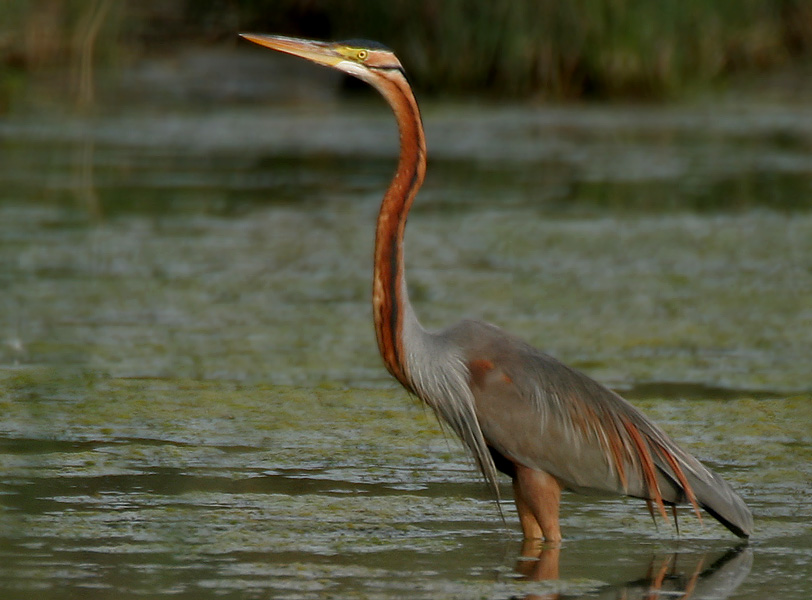Purple heron
(Ardea purpurea)

Description
The purple heron (Ardea purpurea) is a wide ranging species of wading bird in the heron family,Ardeidae.The scientific name comes from Latin ardea "heron",and purpureus,"coloured purple".It breeds in Africa,central and southern Europe,and southern and eastern Asia.The Western Palearctic populations migrate between breeding and wintering habitats whereas the African and tropical-Asian populations are primarily sedentary,except for occasional dispersive movements.It is similar in appearance to the more common grey heron but is slightly smaller,more slender and has darker plumage.It is also a more evasive bird,favouring densely vegetated habitats near water,particularly reed beds.It hunts for a range of prey including fish,rodents,frogs and insects,either stalking them or standing waiting in ambush.Purple herons are colonial breeders and build a bulky nest out of dead reeds or sticks close to the water' edge among reeds or in dense vegetation.About five bluish-green eggs are laid and are incubated by both birds.The young hatch about four weeks later and fledge six weeks after that.The International Union for Conservation of Nature notes that the global population trend is downwards,largely because of the drainage of wetlands,but assesses the purple heron's conservation status as being of "least concern".The purple heron is a large bird,78–97 cm (31–38 in) in length with a standing height from 70 to 94 cm (28 to 37 in) and a 120–152 cm (47–60 in) wingspan.However,it is slender for its size,weighing only 0.5 to 1.35 kg (1.1 to 3.0 lb).It is somewhat smaller than the grey heron,from which it can be distinguished by its darker reddish-brown plumage,and,in adults,its darker grey back.Adults have the forehead and the crown of the head black,with a dark stripe down the back of the neck that terminates in a slender,dangling crest.This is shorter than the crest of the grey heron and does not exceed 140 mm (5.5 in).The sides of the head and the neck are buffish chestnut,with dark streaks and lines down either side of the whole the neck.The mantle is oily brown and the upper scapular feathers are elongated but not the lower ones.The rest of the upper parts and the tail are brownish grey.The front of the neck is paler than the sides and there are some elongated feathers at the base of the neck which are streaked with white,chestnut and black.The breast is chestnut brown,with some blackening at the side,and the belly and under-tail coverts are black.The brownish-yellow beak is long,straight and powerful,and is brighter in colour in breeding adults.The iris is yellow and the legs are brown at the front and yellowish behind.The call is a harsh "frarnk",but is quieter and more high-pitched than that of the grey heron.It is generally a less noisy bird,though similar guttural sounds are heard emanating from the heronry.It is also less robust,and appears somewhat hollow-chested.Its head and neck are more slender and snake-like than the grey heron and its toes much longer.Unlike that bird,it often adopts a posture with its neck extending obliquely,and even nestlings tend to use this stance.
Taxonomic tree:







